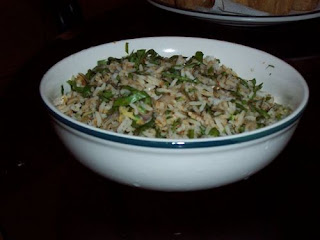Seeding the Future

A man known as the Indiana Jones of agriculture may seem an unlikely 21st Century hero. But his work is heroic in every way and I would like to pay tribute to his and others' selfless efforts in this field.
A documentary on Australian TV highlighted his search for the ancient seeds of our staple food crops - wheat, barley, and even the humble chickpea, of which more later. Faced with constraints of time and finance, unreliable transportation and travel across warzones, and reliant only on his team of assistants, knowledge of the world, sheer determination and belief in his mission, Ken Street set out for the mountainous terrain of Tajikistan in search of what he describes as "green gold".
Wars are being fought over oil, he points out, but these ancient seeds are the holy grail that will ensure humanity's survival into the future.
The problem as he sees it, is that we have lost the biodiversity that made our crop gene pool so resilient. Now our only hope is to reintroduce those elements of genetic strength and capacity to withstand disease back into the genetic "soup". In an article he is quoted "We have lost something like 80 per cent of our agri-biodiversity in the last 100 years. That's shocking. Let's not lose any more. China used to have 10,000 different forms of wheat. Now they have only got a thousand of those left. It's the same for all of our major crops, fruit and vegetables. Which means that really useful diversity - unique sequences of DNA - have just gone extinct."
It could be depressing, except that Street and other agricultural scientists are working against the clock to ensure this precious resource is saved for generations to come and ensure that these seeds will produce crops that have the ability to withstand what would spell out a doomsday scenario (drought conditions, extremes of temperatures, etc.) for less robust strains of crops that we rely on now.
And to make sure that these seeds will be safe, somewhere deep under the permafrost in a remote place called Svalbard in Norway, a vault (befittingly nicknamed the Doomsday Vault because it has been built to withstand all manner of disasters) has been built to house them. You have to love the Norwegian government and those who support the foundation that manages it!
But coming back to the chickpeas - what is it about this humble little bean that makes it so valuable? Well it's a great source of protein and carbohydrate for a start. It's low in fat and very high in calcium (equivalent to yoghurt) and zinc.
And they are great to eat - chickpeas form the basis for heavenly hommous and fantastic felafel, and can be cooked in curries, couscous and salads.
Best of all, though, it could mean fewer people in the world will go hungry because it is an excellent source of cheap nutrition. At the moment most of the world's production goes to feeding livestock!
Labels: chick peas, crops, gene pool, green gold, ken street, seeds, svarblad vault



 A monarch thus reduced to but a shell of his former self must be that old King of some undefined time in England - Lear. Unfortunately, by the time I knew the RSC were in town to put on the play all the cheaper seats had sold out, and I decided my pockets were not deep enough to be able to pay for a premium seat. However, due to a stroke of luck I did manage to attend the press conference since I am now writing for a teen magazine.
A monarch thus reduced to but a shell of his former self must be that old King of some undefined time in England - Lear. Unfortunately, by the time I knew the RSC were in town to put on the play all the cheaper seats had sold out, and I decided my pockets were not deep enough to be able to pay for a premium seat. However, due to a stroke of luck I did manage to attend the press conference since I am now writing for a teen magazine.


